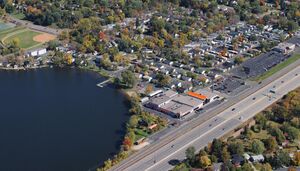
Difference between revisions of "Aaron test MS4 page"
(Created page with "{{alert|We recently updated this page and will continue to work on information about MS4 stormwater management. If you have suggestions, we welcome comments using the comment...") |
|||
| Line 4: | Line 4: | ||
[[file:Check it out.png|150px|thumb|alt=image|<font size=3> [https://stormwater.pca.state.mn.us/index.php?title=MS4_staff_contact_information_and_staff_assignments <b><center>MPCA MS4 staff contact information can be found at this link]</center></b></font size>]] | [[file:Check it out.png|150px|thumb|alt=image|<font size=3> [https://stormwater.pca.state.mn.us/index.php?title=MS4_staff_contact_information_and_staff_assignments <b><center>MPCA MS4 staff contact information can be found at this link]</center></b></font size>]] | ||
[[file:Check it out.png|150px|thumb|alt=image|<font size=3>[https://www.arcgis.com/apps/Cascade/index.html?appid=9af02c9b2a994e56910cce1dbba400c4 The City of Austin, MN, has created this neat web-based story map about stormwater and MS4.]</font size>]] | [[file:Check it out.png|150px|thumb|alt=image|<font size=3>[https://www.arcgis.com/apps/Cascade/index.html?appid=9af02c9b2a994e56910cce1dbba400c4 The City of Austin, MN, has created this neat web-based story map about stormwater and MS4.]</font size>]] | ||
| + | |||
| + | circle 1040 500 30 [[Erosion prevention practices|Erosion prevention practices include 1) planning approaches that minimize the size of the bare soil area and the length of time disturbed areas are exposed to the elements – especially for long, steep slopes and easily erodible soils, 2) diverting or otherwise controlling the location and volume of run-on flows to the site from adjacent areas, 3)keeping concentrated flows in ditches stabilized with vegetation, rock, or other material, and 4)covering bare soil with vegetation, mulch, erosion control blankets, turf reinforcement mats, gravel, rock, plastic sheeting, soil binder chemicals, etc.]] | ||
The municipal separate storm sewer system (MS4) stormwater program is designed to reduce the amount of <span title="any particulate matter that can be transported by fluid flow and which eventually is deposited as a layer of solid particles on the bed or bottom of a body of water"> '''sediment'''</span> and pollution that enters surface and ground water from storm sewer systems. Public entities that own or operate an MS4 play a key role in preventing or reducing the negative impacts stormwater <span title="the portion of rainfall or snowmelt not immediately absorbed into the soil that drains or flows off the land and becomes surface flow"> '''runoff'''</span> has on our valuable water resources. | The municipal separate storm sewer system (MS4) stormwater program is designed to reduce the amount of <span title="any particulate matter that can be transported by fluid flow and which eventually is deposited as a layer of solid particles on the bed or bottom of a body of water"> '''sediment'''</span> and pollution that enters surface and ground water from storm sewer systems. Public entities that own or operate an MS4 play a key role in preventing or reducing the negative impacts stormwater <span title="the portion of rainfall or snowmelt not immediately absorbed into the soil that drains or flows off the land and becomes surface flow"> '''runoff'''</span> has on our valuable water resources. | ||
Revision as of 16:13, 29 April 2024
The municipal separate storm sewer system (MS4) stormwater program is designed to reduce the amount of sediment and pollution that enters surface and ground water from storm sewer systems. Public entities that own or operate an MS4 play a key role in preventing or reducing the negative impacts stormwater runoff has on our valuable water resources.
Proper stormwater runoff management in urbanized areas is especially important for restoring and protecting surface waters. Urbanized areas are more likely to have activities that contribute pollutants to stormwater runoff, like applying anti/deicing mixtures to roads; fueling vehicles; grease, oil, and other spills; landscaping; and using pesticides and fertilizers. Urbanized areas have a large amount of impervious surfaces, or surfaces that rain and snowmelt cannot pass through, such as streets, driveways, rooftops, parking lots and sidewalks. Stormwater runoff from these surfaces travels faster and in higher amounts, damaging rivers, streams, and wetlands; destroying aquatic habitats; increasing the amount of pollutants that enter surface waters; and limiting groundwater recharge.
- What is a municipal separate storm sewer system (MS4)?
- Why is a municipality regulated under the MS4 permit?
Contents
2020 MS4 General Permit
- Link here to the 2020 MS4 General Permit - this is the wiki version of the permit
- Link here to the 2020 MS4 General Permit - this links to a pdf of the permit
2020 MS4 General Permit reissuance
Visit the MS4 General Permit reissuance page for updates on the new MS4 General Permit.
MS4 stormwater permit
Previous permits
Minimum Control Measures
When seeking to manage a Municipal Storm Sewer System (MS4), an effective Stormwater Pollution Prevention Program (SWPPP) has six different components known as Minimum Control Measures (MCMs). Follow this link to learn more about each MCM along with resources and guidance.
Total Maximum Daily Loads (TMDLs)
Total Maximum Daily Loads (TMDLs) are EPA approved amounts of pollutant loading that can occur and have a water body meet water quality standards. Follow this link to learn more about them along with guidance and resources.
Tools and resources
- Municipal Separate Storm Sewer System (MS4) toolkit: A collection of resources for use by stormwater program staff. It is intended to help entities regulated under the MS4 program meet the requirements of the general permit. It offers a wide range of downloadable stormwater education information including sample fact sheets, newsletters, videos, and other resources.
- MS4 Digital Document Library: Provides guidance to help local MS4 staff meet the requirements of the six Minimum Control Measures (MCMs) in the 2013 MS4 General Permit and assist with overall stormwater management. In addition to general guidance documents and photos/graphics, the Digital Document Library has example documents that stormwater staff are using to manage their stormwater pollution prevention programs (SWPPPs). All documents in the Digital Document Library are MPCA reviewed and available for anyone to download and use.
- MS4 mapping tool: An interactive online map tool that can be used to view and explore Minnesota MS4 boundaries, defined urbanized areas, impaired waters, outstanding resource value waters, trout waters and approved TMDL study areas.
- NEW Assessing total suspended sediment and total phosphorus removal efficiency of permittee owned/operated constructed stormwater ponds: guidance related to assessing the total suspended sediment (TSS) and total phosphorus (TP) removal efficiency of MS4 (Municipal Separate Storm Sewer System) permittee owned/operated ponds constructed and used for the collection and treatment of stormwater.
- Pollution prevention guidance fact sheets: A collection of links to a variety of Minnesota Stormwater Manual fact sheets on stormwater pollution prevention methods within MS4s.
MS4 audit guidance
The U.S. Environmental Protection Agency (EPA) mandates the Minnesota Pollution Control Agency (MPCA) to evaluate MS4 permittees for compliance with the MS4 General Permit. The MPCA does this through compliance audits. To find out more information about the audit process see the pages below:
MPCA MS4 technical assistance
- MPCA MS4 website
- MPCA MS4 staff contact information
- MS4 case studies
- MS4 webinars and videos
- 2017 MS4 Technical Assistance and Outreach Needs Survey Results

